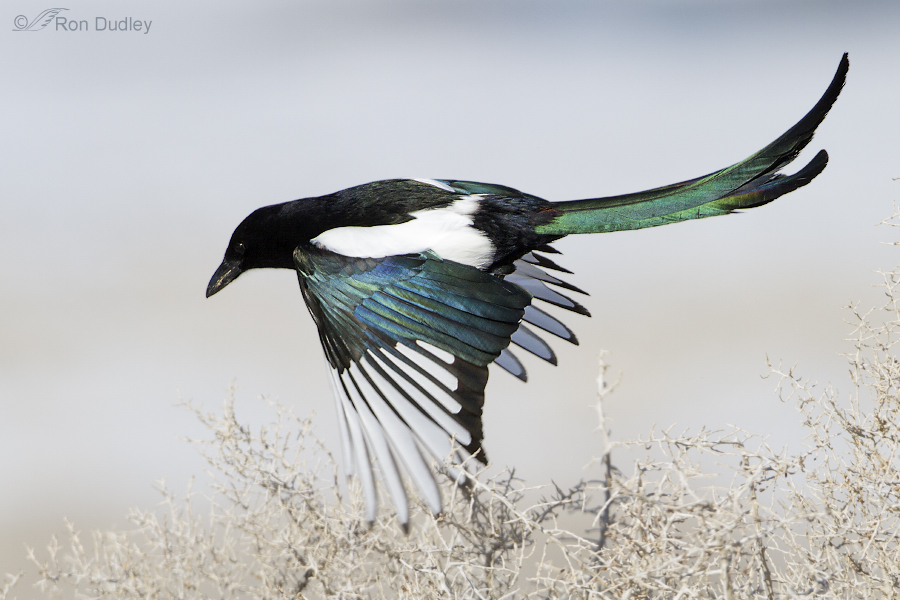I’ve spent the last two mornings photographing Black-billed Magpies in the midst of nest construction. These birds often re-use old nests and this is at least the third year they have used the same one. Even when “recycling” the nest like this, weeks of work go in to refurbishing it – they bring in a completely new lining of grass, mud, rootlets and even bison fur. And they add an amazing number of new twigs to the basic structure. These are industrious birds!
I’ve said before that this species is my most challenging avian photographic subject and that fact has been reinforced this week. There are several reasons for that, including:
- the deep black and bright white combination is hugely difficult to expose properly
- that aggravatingly long tail makes composition difficult and it is very easy to clip or cut off in action shots
- they close their nictitating membrane more than any other bird I’ve photographed and when they do its color is a blue-white which is almost shockingly apparent against the black head
- when they take off from an elevated perch they typically flap once and then fold their wings tightly against the body at exactly the moment when it’s easiest to get them in flight, resulting in what I call a “torpedo-bird” flight posture that is less than desirable
- the dark eye set against a black head makes it very difficult to get a good catch light in the eye
In the last two days I’ve taken over 1200 shots of these magpies and about 95% of them were garbage, largely due to the reasons mentioned above. I keep telling myself that I enjoy the challenge…
1/2000, f/7.1, ISO 500, 500 f/4, natural light
The nest is buried in this greasewood bush next to a road that has lots of human activity so these birds are accustomed to vehicles. I photograph them from my pickup and they are not disturbed in the least. The greasewood has hundreds of long vertical twigs which makes getting unobstructed take-off shots a challenge.
Occasionally when the light angle is exactly right the iridescence you get is quite spectacular on a bird that is otherwise lacking in color other than black and white. I’m becoming quite the student of the best angle to get the iridescence.
Soon I plan on doing a post on their nest-building behaviors. But this morning I only had time for this one image.
Ron



And your magpies, unlike ours, do not swoop people, cats and dogs during nesting season. Our local councils are forced to put up signs in the offending birds territories. Which I really like. The birds are left in peace unless they inflict serious damage on a person. And even then where possible they are relocated.
Your magpies are prettier than ours as well. Ours have a much shorter tail and no irridescence – I still love them though. And their call is enchanting and spells home to me.
lovely. Look forward to the nest building as I have watched them in the past.they have a definite way of doing it.
I love this one! Sooooo beautiful. Well worth the 1200 shots to achieve this.
Thanks, Susan. Taking the shots is fun. It’s the image culling that’s a pain in the patoot…
A spectacular capture, Ron. By coincidence, I posted on Corvids generally today. You’ll note there are no magpies in the blog post. You’ve explained why in your post, if you substituted alder and willow for greasewood.
I’d trade all six of my photos for one as good as yours…
/WC
Thanks, WC. Two years ago there were no long spikes in that greasewood and it was relatively easy to get landing and take-off shots of the magpies without getting “stuff” in front of them. But there was a growth spurt last year and I’m dealing with the consequences.
You sure got the color in this one…who says the magpie is black and white?
“who says the magpie is black and white?”
I liked that, Peggy. All depends on the light angle, doesn’t it?
Can’t quite make out what it says but thank you for this lovely picture to brighten a dreary March day.
Thanks, Janice. Are you using an iPad? – see comment below.
I understand your reasons for not sending your photos via email, but I’ have great difficulty reading your blog on my iPad. The type is VERY small. I can enlarge it but then can’t keep the whole page in the window and I have to keep adjusting it. Not a huge problem, but I wonder if it’s possible to use larger type in your blog. Did not have a problem at all with your email posts. Thanks very much. I love your posts and photos!
Janet, I’m working at trying to figure out why the font is so small on an iPad. This is the first time I’ve heard that this is a problem.
Janet, I’ve done some research on this and asked some friends who have iPads about it. As far as I can tell this is an issue with iPads only, as pc’s, iMacs and phones apparently don’t have the problem. The theme I’m using for this blog has very limited font options and I’m leary of tinkering with it for fear of causing other issues with non-iPad users.
Thanks very much for checking, Ron. I’ll make the best of it. I appreciate your blog so very much.
Thank you, Chris, Maria and Tana.
Beautiful! All dressed up for spring!
Absolutely formidable. This bird is for me the king of “iridescence”.
Wow. That’s all, just– Wow.